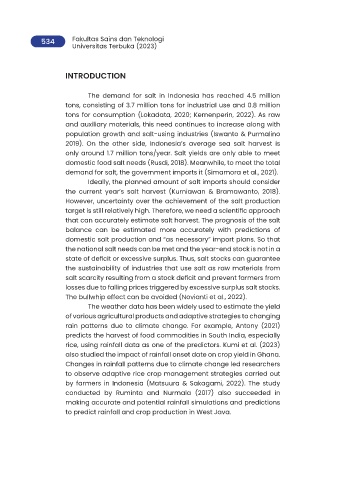Page 573 - Trends in Science and Technology fo Sustainable Living
P. 573
534 Fakultas Sains dan Teknologi
Universitas Terbuka (2023)
INTRODUCTION
The demand for salt in Indonesia has reached 4.5 million
tons, consisting of 3.7 million tons for industrial use and 0.8 million
tons for consumption (Lokadata, 2020; Kemenperin, 2022). As raw
and auxiliary materials, this need continues to increase along with
population growth and salt-using industries (Iswanto & Purmalino
2019). On the other side, Indonesia’s average sea salt harvest is
only around 1.7 million tons/year. Salt yields are only able to meet
domestic food salt needs (Rusdi, 2018). Meanwhile, to meet the total
demand for salt, the government imports it (Simamora et al., 2021).
Ideally, the planned amount of salt imports should consider
the current year’s salt harvest (Kurniawan & Bramawanto, 2018).
However, uncertainty over the achievement of the salt production
target is still relatively high. Therefore, we need a scientific approach
that can accurately estimate salt harvest. The prognosis of the salt
balance can be estimated more accurately with predictions of
domestic salt production and “as necessary” import plans. So that
the national salt needs can be met and the year-end stock is not in a
state of deficit or excessive surplus. Thus, salt stocks can guarantee
the sustainability of industries that use salt as raw materials from
salt scarcity resulting from a stock deficit and prevent farmers from
losses due to falling prices triggered by excessive surplus salt stocks.
The bullwhip effect can be avoided (Novianti et al., 2022).
The weather data has been widely used to estimate the yield
of various agricultural products and adaptive strategies to changing
rain patterns due to climate change. For example, Antony (2021)
predicts the harvest of food commodities in South India, especially
rice, using rainfall data as one of the predictors. Kumi et al. (2023)
also studied the impact of rainfall onset date on crop yield in Ghana.
Changes in rainfall patterns due to climate change led researchers
to observe adaptive rice crop management strategies carried out
by farmers in Indonesia (Matsuura & Sakagami, 2022). The study
conducted by Ruminta and Nurmala (2017) also succeeded in
making accurate and potential rainfall simulations and predictions
to predict rainfall and crop production in West Java.

